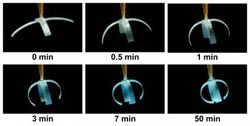Scotch tape finds new use as grasping 'smart material'

The researchers used Scotch tape to create a tiny grasping claw that collects droplets of water, an innovation could be used to collect water samples for environmental testing. The material, seen here, becomes flexible when exposed to humidity and returns to its original shape when dry. (Manuel Ochoa, Purdue University) A publication-quality image is available at http://news.uns.purdue.edu/images/2012/ziaie-grippers.jpg<br><br>Credit: Manuel Ochoa, Purdue University<br>
Researchers used a laser to form slender half-centimeter-long fingers out of the tape. When exposed to water, the four wispy fingers morph into a tiny robotic claw that captures water droplets.
The innovation could be used to collect water samples for environmental testing, said Babak Ziaie, a Purdue University professor of electrical and computer engineering and biomedical engineering.
The Scotch tape – made from a cellulose-acetate sheet and an adhesive – is uniquely suited for the purpose.
“It can be micromachined into different shapes and works as an inexpensive smart material that interacts with its environment to perform specific functions,” he said.
Doctoral student Manuel Ochoa came up with the idea. While using tape to collect pollen, he noticed that it curled when exposed to humidity. The cellulose-acetate absorbs water, but the adhesive film repels water.
“So, when one side absorbs water it expands, the other side stays the same, causing it to curl,” Ziaie said.
A laser was used to machine the tape to a tenth of its original thickness, enhancing this curling action. The researchers coated the graspers with magnetic nanoparticles so that they could be collected with a magnet.
“Say you were sampling for certain bacteria in water,” Ziaie said. “You could drop a bunch of these and then come the next day and collect them.”
Findings will be detailed in a presentation during a meeting of the Materials Research Society in Boston from Sunday (Nov. 25) to Nov. 30. Experiments at Purdue's Birck Nanotechnology Center were conducted by Ochoa, doctoral student Girish Chitnis and Ziaie.
The grippers close underwater within minutes and can sample one-tenth of a milliliter of liquid.
“Although brittle when dry, the material becomes flexible when immersed in water and is restored to its original shape upon drying, a crucial requirement for an actuator material because you can use it over and over,” Ziaie said. “Various microstructures can be carved out of the tape by using laser machining. This fabrication method offers the capabilities of rapid prototyping and batch processing without the need for complex clean-room processes.”
An animated GIF of the gripper closing is available at https://engineering.purdue.edu/ZBML/img/research/plain-gripper-closing.gif
The materials might be “functionalized” so that they attract specific biochemicals or bacteria in water.
Writer: Emil Venere, 765-494-4709, venere@purdue.edu
Sources: Babak Ziaie, 765-494-0725, bziaie@purdue.edu
Manuel Ochoa, ochoam@purdue.edu
Related websites:
Babak Ziaie: https://engineering.purdue.edu/ECE/People/profile?resource_id=2839
Birck Nanotechnology Center: http://www.purdue.edu/discoverypark/nanotechnology/
Other animated GIFs using the material to create a mini-Purdue logo:
https://engineering.purdue.edu/ZBML/img/research/pu-tape-1-small.gif
https://engineering.purdue.edu/ZBML/img/research/pu-tape-2-small.gif
IMAGE CAPTION:
The researchers used Scotch tape to create a tiny grasping claw that collects droplets of water, an innovation could be used to collect water samples for environmental testing. The material, seen here, becomes flexible when exposed to humidity and returns to its original shape when dry. (Manuel Ochoa, Purdue University)
A publication-quality image is available at http://news.uns.purdue.edu/images/2012/ziaie-grippers.jpg
IMAGE CAPTION:
The graspers were coated with magnetic particles, which could allow researchers to retrieve the devices in the field by using a magnet. (Manuel Ochoa, Purdue University)
A publication-quality image is available at http://news.uns.purdue.edu/images/2012/ziaie-grippers2.jpg
ABSTRACT
Laser-Micromachined Magnetically-Functionalized Hygroscopic Bilayer: A Low-Cost Smart Material
Manuel Ochoa 1,4, Girish Chitnis 2,4, and Babak Ziaie 1,3,4*
1School of Electrical and Computer Engineering, Purdue University
2School of Mechanical Engineering
3 Weldon School of Biomedical Engineering
4Birck Nanotechnology Center
In this paper, we describe the design, fabrication, and characterization of magnetically functionalized humidity-responsive bilayers. We investigated two different ferrofluid embedded material structures: 1) cellulose-acetate sheet bonded to an acetate-backed adhesive (3M Scotch® GiftWrap Tape) (CA/GWT) and 2) a commercially available acetate-backed adhesive (3M Scotch® MagicTape) (MT). Cantilevers and other mechanical structures such as grippers were fabricated using laser micro-machining and exposed to humidity and magnetic fields. Such bilayers take advantage of the hygroscopic properties of cellulose acetate for their humidity response while simultaneously allowing one to remotely manipulate the structure using a magnetic field. The maximum radius of curvature in a humidity saturated environment for a CA/GWT cantilever (2 mm × 19 mm × 157 µm) was measured to be 7 mm, whereas the MT showed a smaller radius of curvature (
Media Contact
More Information:
http://www.purdue.eduAll latest news from the category: Materials Sciences
Materials management deals with the research, development, manufacturing and processing of raw and industrial materials. Key aspects here are biological and medical issues, which play an increasingly important role in this field.
innovations-report offers in-depth articles related to the development and application of materials and the structure and properties of new materials.
Newest articles

Superradiant atoms could push the boundaries of how precisely time can be measured
Superradiant atoms can help us measure time more precisely than ever. In a new study, researchers from the University of Copenhagen present a new method for measuring the time interval,…

Ion thermoelectric conversion devices for near room temperature
The electrode sheet of the thermoelectric device consists of ionic hydrogel, which is sandwiched between the electrodes to form, and the Prussian blue on the electrode undergoes a redox reaction…

Zap Energy achieves 37-million-degree temperatures in a compact device
New publication reports record electron temperatures for a small-scale, sheared-flow-stabilized Z-pinch fusion device. In the nine decades since humans first produced fusion reactions, only a few fusion technologies have demonstrated…





















